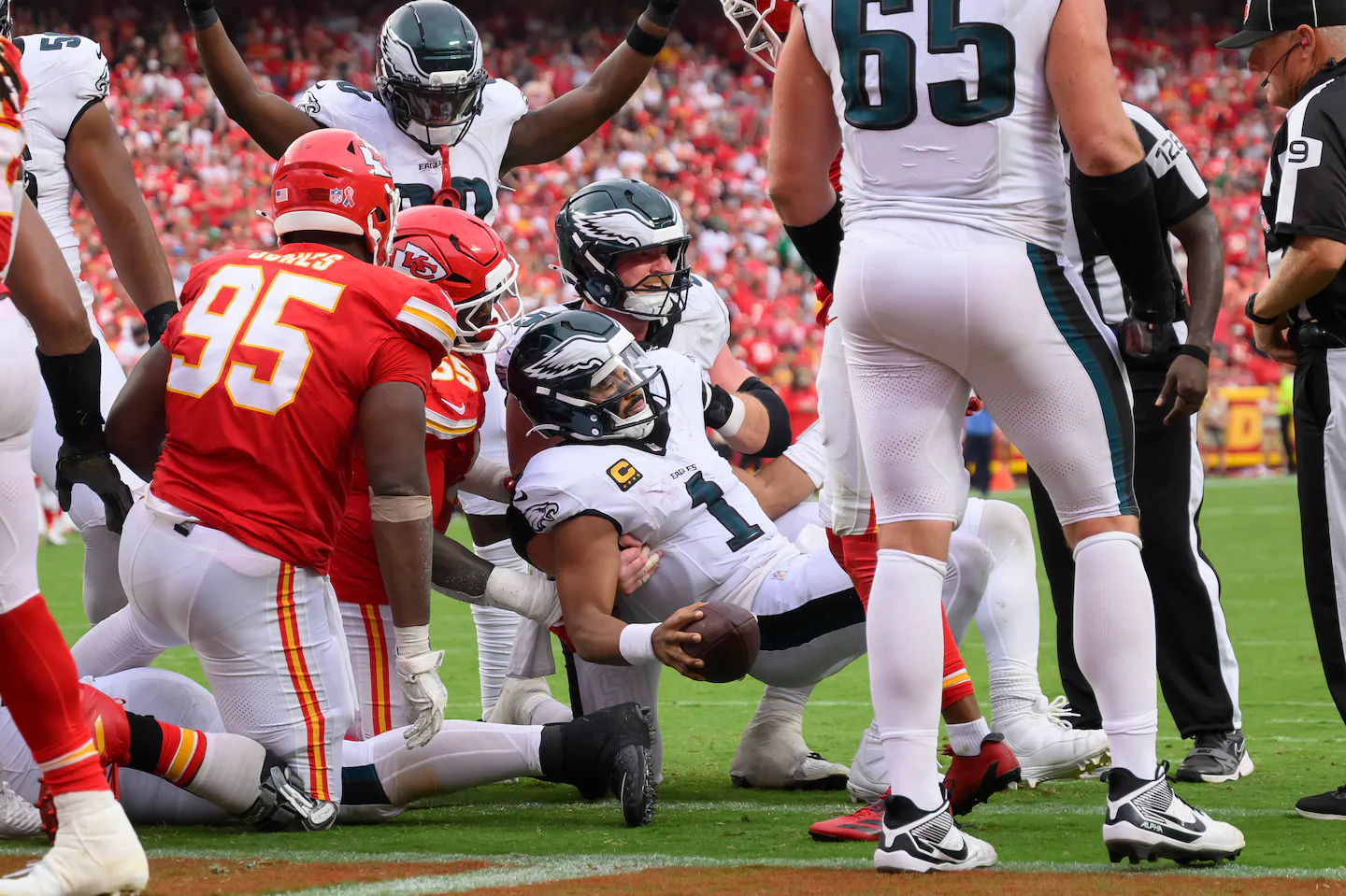
It forces us to ponder an age-old question in sports: where’s the line between excellence and unfair advantage? Rule changes often address someone or some group performing too proficiently. Baseball lowered the mound five inches after the Year of the Pitcher in 1968, punctuated by Bob Gibson posting a 1.12 earned run average. The NBA widened the lane from 12 feet to 16 feet in 1964 to combat another Philadelphia-born force, Wilt Chamberlain. College basketball outlawed the dunk in 1967 in response to young Lew Alcindor, better known as Kareem Abdul-Jabbar. The NHL has been playing “Honey, I shrunk the goalies’ equipment” for two decades.
The tush push has become a non-competitive, predictable play when the Eagles run it. Therein lies the quandary for the NFL. The league has worked assiduously to eliminate non-competitive plays, tweaking the extra point and the kickoff. The dilemma is should it continue to allow a non-competitive play that saps the game of intrigue, or does it punish the potency of a single team and legislate it out of the game?
Yours truly will do what teams can’t — defend the tush push. Before abolishing the tush push, the league should try to better legislate and officiate the souped-up sneak first. The middle ground is a rule change that allows no more than one player to push. The Eagles normally line up with two players to push hulking quarterback Jalen Hurts.
Limiting the pushing to one player should give defenses more of a fighting chance. If teams still can’t stop the play, then it’s more about Hurts being the Babe Ruth of quarterback sneakers.
A single pusher returns the play to its provenance. ESPN’s Stephen Holder interviewed former Eagles offensive coordinator Shane Steichen about the origin of the short-yardage Holy Grail in an extensive story on the tush push. Originally, the play featured just one player pushing the quarterback from behind, said Steichen, now coach of the Indianapolis Colts. Then the Eagles evolved it.
Something has to give on the brotherly shove. Allowing it to go on as is isn’t healthy for the product.
The play has become a near fait accompli for Philly that lowers the entertainment value of tense, got-to-have-it, short-yardage situations. According to ESPN, the Eagles have converted the tush push 96.6 percent of the time in fourth-and-1 situations since 2022. The league average is 67 percent during that same time frame.
The nadir was the football farce created in last year’s NFC Championship game by the futile attempts of Washington Commanders linebacker Frankie Luvu to get a jump on the play, literally.
The counterargument is that only Philadelphia is this automatic.
Buffalo is the team that employs it second-most. The Eagles and Bills combined to run 163 pushes between 2022 and 2024, more than the rest of the NFL combined, according to ESPN.
Bills quarterback Josh Allen was stopped in the AFC Championship game by the Kansas City Chiefs. But those same Chiefs were powerless to stop it in the Super Bowl against the Eagles, or in a Super Bowl rematch last Sunday in Kansas City — in which Philly used it six times, tying the most they’ve ever employed it, according to ESPN.
That must be considered — the team with the most visible tush push denial ever looked utterly helpless against the Eagles.
Four of the tush pushes resulted in first downs or touchdowns. Each of the two times they were stopped, the Eagles simply lined up and ran the play again successfully, scoring a touchdown and netting a first down that allowed them to ice the game without Patrick Mahomes getting the ball back.
We know how the NFL feels about Mahomes not getting a chance to win. That’s one of the reasons the overtime rules were tweaked.
It doesn’t help when the Eagles are allowed to get away with false starts on a play where every inch and angle of leverage counts.
“If guys are moving early, then you’ve got to call that,” Chiefs coach Andy Reid said postgame.
Reid wasn’t alone.
Former Patriots quarterback Tom Brady, who was calling the game for Fox, also singled out missed false starts by Philadelphia.
It was the TB12 announcing equivalent of him telling NFL officials to “study the rulebook” like he once chided the Baltimore Ravens to do after the Patriots used an eligible-ineligible receiver strategy to come back against in the 2014 season’s playoffs.
On a crucial 1-yard touchdown scored on fourth-and-goal in the fourth quarter, Eagles right guard Tyler Steen appeared to get a jump start before the snap.
Steen fired early on a critical third-and-1 from the Philly 25 with 5:29 left in the game. Kansas City players frantically signaled for a false start to no avail.
The NFL doesn’t disagree with those exasperated KC players. According to the Washington Post, in its teaching tape to officials sent to all teams, the NFL admitted that Philadelphia should’ve been called for a false start.
The push to eliminate the people-mover play is nothing new. It narrowly survived banishment this offseason after a spirited and heated debate at the NFL owners meetings in March and the league’s spring meeting in May, spared by a meager two votes. It takes a three-fourths vote of the 32 NFL teams to pass a rule change.
The Patriots were one of the 10 teams that voted not to abolish the tush push (the amended proposal sponsored by the Green Bay Packers covered all plays involving aiding ballcarriers via pushing).
When push comes to shove, the NFL must do something about the tush push. Philadelphia has created a first-down cheat code, but rendering it extinct should be a last resort.



